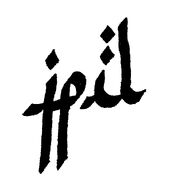Sengdigon is a language used by the inhabitants of the planet Ansinia. It is written using 4 different scripts: Sengdi, Gonai, Datskai and Lengdiansini (abrv. Ansini) and while the scripts are different, there are very little to no differences in the spoken language between countries.
Geography[]

There are 3 countries in Ansinia: Sengdi, Gonai and Datskai (creative right?) None of them like each other so there is very little trade/cultural diffusion/etc...
Scripts[]
There are 4 scripts used to write Sengdigon:
- Sengdi- A cursive abugida used by the Sengdi people in the north
- Gonai- An abugida resembling Hindi used by the Gonai people in the south
- Datskai- A revised, non-cursive form of the Sengdi abugida
- Ansini- A highly irregular abugida used by the Elders (no longer in use)
Sengdi[]

"Sengdi" Written in Sengdi
The Sengdi abugida is extemely simple. It is composed of characters formed by two strokes.Generally, if the 2 strokes point upward, the consonant is voiced; if they both point down, the consonant is unvoiced. The only exception to this is the consonants [r], [s] and [z] (although the s and z follow the rule, both strokes don't point in the same direction), and the vowel letter (used to indicate a vowel sound that is not attached to a consonant).
The Sengdi script is written right to left in a cursive style (letters are connected). The letters are written on a base line with two heights for each ascender and two heights for each descender, a half and full. To make words, you need to have diacritics to signify vowels.
Consonants[]

Sengdi Consonants
The Sengdi abugida contains the consonants: [b], [d], [g], [l], [m], [n], [p], [t], [k], [r], [s] and [z] (the [ŋ] consonant is no longer used except when writing the three holy words: Seŋdi, Seŋ or Sirkoŋgo, and was replaced by a silent* [n] followed by a [g]) and the vowels (marked with diacritics): [a], [ɛ], [i], [o], [u], and a silencer.*
Vowels[]

Sengdi Vowel Diacritics
Vowels are written using diacritics. One dot signifies a short vowel and two signifies a long vowel, no mater the direction. A fleck signifies that the letter should be pronounced with no vowel sound and should be combined with the next consonant.
Gonai[]

"Gonai" written in Gonai
The Gonai abugida is also extemely simple. It is composed of characters formed by one to three strokes connected to a baseline above.The voiced consonants are connected to the baseline and descend below while the unvoiced consonants are connected to the baseline with an extra mark above them.

Gonai Consonants
Consonants[]
The Gonai abugida contains the consonants: [b], [d], [g], [l], [m], [n], [p], [t], [k], [r], [s], [z], [ʧ] and [ʒ] and the vowels (marked with diacritics underneath each letter): [a], [ɛ], [i], [o] and [u]

Gonai vowel diacritics
Vowels[]
The vowels in gonai, [a], [ɛ], [i], [o] and [u], are marked underneath each letter (except for [u] which is above and below.) There is no mark for a consonant without a vowel sound and if there is a need for a vowel that is unattached to a consonant, it is written in the same place as a letter without being connected to the baseline. If the unattached vowel is at the beginning of a word, it is attached to the word beginning marker while still remaining unattached to the baseline.
